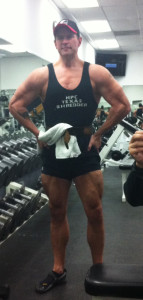I could write a treatise on the benefits of low-calorie dieting. Granted, the subject is not that popular these days. Most diet gurus espouse a slight reduction at best in kcal intake. Some go even further down the line and suggest that one should attempt to increase one’s metabolic rate to the point of being able to consume more calories.
More calories = more muscle. More muscle = more need for calories. The cycle goes from there.
But what if I told you that I built seven pounds of muscle, at the age of 48, on 1400-1600 kcals per day? Would you believe me? Sure, if I weighed in at 130 pounds…perhaps.
I weighed myself today at 196.4 pounds, thank you very much.
During this time, I dropped my body fat lower than it has ever been—at least as low as it is going to go without radical amounts of cardio and cannibalizing precious muscle mass. Have a looksie…

Now, obviously, there is a catch. You cannot consume such a low number of kcals without spiking your calories every 3-4 days. During these spikes, I’ll consume upwards of 4500 kcals, and occasionally indulge in my favorite foods. This keeps me sane, and it keeps my body’s metabolic pathways alive and kicking.
The end result? All the benefits of low-calorie dieting (faster fat loss, longevity benefits, anti-aging benefits, and so on) without having to cram food down my mouth every 3rd hour on the hour, along with the ability to enjoy an abundance of calorie-rich foods several times a week.
That “life extension benefits” really cannot be overemphasized. While it can be argued that consuming high calories every 3-4 days breaks the spirit of the law governing lower-calorie diets for promoting life extension, the math still works out over the course of a week—you still consume fewer calories than your body requires for consumption-only survival.
This means you pull the energy you need from the places you hate the most: Visceral fat stores, sub-Q fat, and, yes, glycogen. That’s okay, however, as when the liver is drained of glycogen, your triglyceride levels tend to drop, and small particle LDL decreases. For those of us concerned about our hearts, this is a wonderful thing.
In future posts, I’ll cover some of the drawbacks to this approach. For the rest of us seeking to drop the body fat faster than normal, without having to eat until you just can’t eat any more, my lower-calorie approach may be just the dream ticket you’ve been searching for. Just remember to cycle your training accordingly. Hit your heaviest workouts on and the day after your high-calorie days (days 1-2). Take the following day off (or do cardio only; day 3), and have a short, high-intensity workout on the fourth day of the cycle.




















1 Comment
You must be logged in to post a comment Login